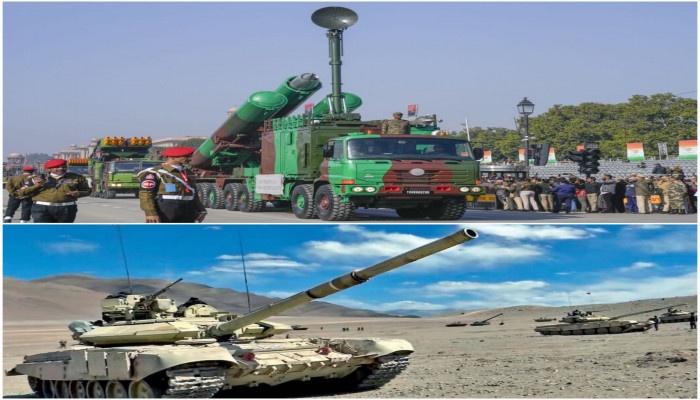India targets $1.6 billion in defence exports to meet 2025 goal
- In Reports
- 09:05 PM, Feb 17, 2025
- Myind Staff
The Defence Production and Export Promotion Policy (DPEPP) 2020 was launched to boost India's defence exports to ₹35,000 crore ($5 billion) by 2025. According to recent data from Defence Minister Rajnath Singh, India has already reached ₹21,083 crore in exports. With the current exchange rate, the $5 billion target would now equal over ₹43,000 crore.
Though India still imports more defence equipment than it exports, it has made significant progress in selling arms, ammunition, radars, electronics, rockets, naval platforms, drones, and other components to over 100 countries worldwide. So, who is buying Indian defence products and why? India's relatively low-cost products make it an attractive alternative to China.
Indian-made systems like the Akash and BrahMos missiles, developed by the Defence Research and Development Organisation (DRDO), are reportedly more affordable than their Western and Russian counterparts, with a price difference of 30% to 40%. Companies such as Hindustan Aeronautics, Bharat Dynamics, Bharat Electronics, L&T, and Mishra Dhatu Nigam play a role in their production.
Countries like the Philippines, Indonesia, and Vietnam view India as a counterbalance to China’s growing influence. At the same time, nations in the Middle East and Africa see India as a reliable supplier that doesn’t impose the political conditions often seen with Western countries.
German Chancellor Olaf Scholz has emphasised the need for stronger defence cooperation with India as Germany, Europe’s largest economy, increased its defence budget and moved away from reliance on Russian weapons. During his visit to New Delhi in October 2024, he noted the interest of German companies in joint projects, such as submarine construction. He remarked, "We need more cooperation, not less."
France is in advanced conversations to acquire India’s Pinaka multi-barrel rocket launcher system, marking a significant shift in its role as a supplier to India.
India’s lower labour and production costs enable competitive pricing without sacrificing quality. The country also provides attractive financing options like deferred payments and government-backed credit lines. For instance, the Export-Import Bank of India (EXIM Bank) offered Vietnam a $100 million credit line for defence purchases, reinforcing strategic defence ties between the two nations.
In the same way, the Reserve Bank of India (RBI) backs export credit schemes with favourable interest rates, making it financially viable for buyers.
In the 2025 Budget, some steps have been taken to raise defence manufacturing and exports. A total of ₹1.80 lakh crore has been allocated to the Armed Forces under the capital budget, focusing on modernisation. Of this amount, ₹1.12 lakh crore will be spent on procurement from domestic industries. The allocation for DRDO has been increased by 12.5%, reaching ₹26,816.8 crore. A significant portion of ₹14,923.82 crore has been allocated for capital expenditure and funding R&D projects. "The increased allocation under the capital head of DRDO will further provide adequate financial resources in funding the projects to be taken up in collaboration with private parties through flagship scheme of DRDO, i.e. Technology Development Fund," a government of India report stated on February 1.
The capital budget for the Indian Coast Guard has been raised to ₹5,000 crore for FY26, up from ₹3,500 crore in the previous year. "ICG not only strengthens coastal security but also provides assistance to neighbouring countries and commercial ships during (an) emergency through faster response," the press note counted.
India has signed recent pacts for this. Amid growing tensions with China, the Philippines has agreed to purchase BrahMos missiles, with the deal valued at $375 million, as stated in a press release from BrahMos Aerospace. India is also in advanced discussions with Indonesia regarding a similar deal to supply BrahMos missiles.
The UAE and Sri Lanka are considering arms purchases and military cooperation to strengthen their security ties with India. India provides military training and conducts joint exercises with African countries like Ghana, South Africa, and Egypt. Italy, Russia, and the Maldives have also bought defence equipment from India.
India’s growing presence in the global arms market can be attributed to its focus on indigenisation, affordable manufacturing and shifting geopolitical dynamics. With defence exports expected to hit ₹50,000 crore by March 2029, India is emerging as a viable alternative to established arms suppliers.
To maintain this growth, India will need ongoing investment in research and development, technology transfers and an enhanced global marketing approach to stay competitive in the changing defence industry.







Comments